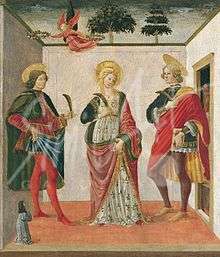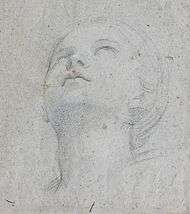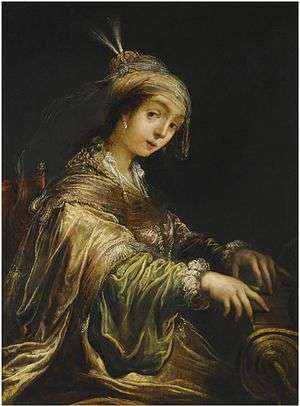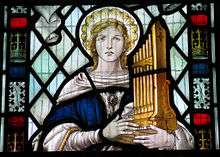Saint Cecilia
| Saint Cecilia | |
|---|---|
|
Personification of Music by Antonio Franchi, circa 1650 | |
| Virgin and Martyr | |
| Born |
2nd century AD Rome |
| Died | Sicily |
| Major shrine | Santa Cecilia in Trastevere, Rome |
| Feast | November 22 |
| Attributes | Flute, organ, roses, violin, harp, harpsichord, singing |
| Patronage | Church music, great musicians, poets; Albi, France; Archdiocese of Omaha; Mar del Plata, Argentina |
Saint Cecilia (Latin: Sancta Caecilia) is the patroness of musicians. It is written that as the musicians played at her wedding she "sang in her heart to the Lord".[1][2] Her feast day is celebrated in the Latin Catholic, Eastern Catholic, Anglican, and Eastern Orthodox churches on November 22.[3] She is one of seven women, excluding the Blessed Virgin, commemorated by name in the Canon of the Mass.
While the details of her story appear to be fictional, her existence and martyrdom are considered a historical fact. She is said to have been beheaded with a sword. An early Roman Christian church, Santa Cecilia, was founded in the fourth century in the Trastevere section of Rome, reputedly on the site of the house in which she lived. A number of musical compositions are dedicated to her, and her feast day, November 22, became the occasion for concerts and musical festivals.
Life

St. Cecilia is one of the most famous of the Roman martyrs, even if the familiar stories about her are apparently not founded on authentic material.[4] According to Johann Peter Kirsch, while it is a pious romance, like so many others compiled in the fifth and sixth century, the existence of the martyrs, however, is a historical fact. The relation between St. Cecilia and Valerianus, Tiburtius, and Maximus, mentioned in the Acts of the Martyrs, has perhaps some historical foundation. Her feast day has been celebrated since about the fourth century.[5]
It was long supposed that she was a noble lady of Rome[2] who, with her husband Valerian, his brother Tiburtius, and a Roman soldier named Maximus, suffered martyrdom in about 230, under the Emperor Alexander Severus.[6] The research of Giovanni Battista de Rossi[7] agrees with the statement of Venantius Fortunatus, Bishop of Poitiers (d. 600), that she perished in Sicily under Emperor Marcus Aurelius between 176 and 180.
According to the story, despite her vow of virginity, she was forced by her parents to marry a pagan nobleman named Valerian. During the wedding, Cecilia sat apart singing to God in her heart, and for that she was later declared the saint of musicians.[2] When the time came for her marriage to be consummated, Cecilia told Valerian that watching over her was an angel of the Lord, who would punish him if he sexually violated her but would love him if he respected her virginity. When Valerian asked to see the angel, Cecilia replied that he could if he would go to the third milestone on the Via Appia and be baptized by Pope Urban I. After following Cecilia's advice, he saw the angel standing beside her and crowning her with a chaplet of roses and lilies.[2]
The martyrdom of Cecilia is said to have followed that of her husband Valerian and his brother at the hands of the prefect Turcius Almachius.[8] The legend about Cecilia’s death says that after being struck three times on the neck with a sword, she lived for three days, and asked the pope to convert her home into a church.[4]
Cecilia was buried at the Catacombs of St. Callistus, and then transferred to the Church of Santa Cecilia in Trastevere. In 1599, her body was found still incorrupt, seeming to be asleep.[2]
There is no mention of Cecilia in the Depositio Martyrum, but there is a record of an early Roman church founded by a lady of this name, Santa Cecilia in Trastevere.[9]
Santa Cecilia in Trastevere

The church of Santa Cecilia in Trastevere is reputedly built on the site of the house in which she lived. The original church was constructed in the fourth century; during the ninth century, Pope Paschal I had remains which were supposedly hers buried there. In 1599, while leading a renovation of the church, Cardinal Paolo Emilio Sfondrati had the remains, which he reported to be incorrupt, excavated and reburied.[10]
Meaning of the name 'Cecilia'
The name "Cecilia" was shared by all women of the Roman gens known as the Caecilii, whose name may be related to the root of caecus ("blind"). Legends and hagiographies, mistaking it for a personal name, suggest fanciful etymologies. Among those cited by Chaucer in "The Second Nun's Tale" are: lily of heaven; the way for the blind; contemplation of heaven and the active life; as if lacking in blindness; a heaven for people to gaze upon.[11]
Patroness of musicians
The first record of a music festival in her honor was held at Évreux in Normandy in 1570.[12]
The Accademia Nazionale di Santa Cecilia in Rome, Italy is one of the oldest musical institutions in the world. It was founded by the papal bull, Ratione congruit, issued by Sixtus V in 1585, which invoked two saints prominent in Western musical history: Gregory the Great, after whom Gregorian chant is named, and Saint Cecilia, the patron saint of music.
Her feast day became an occasion for musical concerts and festivals that occasioned well-known poems by John Dryden and Alexander Pope[13] and music by Henry Purcell (Ode to St. Cecilia); several oratorios by Marc-Antoine Charpentier (In honorem Caeciliae, Valeriani et Tiburtij canticum; and several versions of Caecilia virgo et martyr to libretti probably written by Philippe Goibaut); George Frideric Handel (Ode for St. Cecilia's Day; Alexander's Feast); Charles Gounod (St. Cecilia Mass); as well as Benjamin Britten, who was born on her feast day (Hymn to St Cecilia, based on a poem by W. H. Auden). Herbert Howells' A Hymn to Saint Cecilia has words by Ursula Vaughan Williams; Gerald Finzi's "For Saint Cecilia", Op. 30, was set to verses written by Edmund Blunden; Michael Hurd's 1966 composition "A Hymn to Saint Cecilia"[14] sets John Dryden's poem; and Frederik Magle's Cantata to Saint Cecilia is based on the history of Cecilia.[15] The Heavenly Life, a poem from Des Knaben Wunderhorn (which Gustav Mahler used in his Symphony No. 4) mentions that "Cecilia and all her relations make excellent court musicians."
From the name of St. Cecilia comes Cecyliada, the name of festival of sacred, choral and contemporary music, held from 1994 in Police, Poland.
Legacy

Cecilia symbolizes the central role of music to the liturgy.[4]
The Sisters of Saint Cecilia, religious sisters, shear the lambs' wool used to make the palliums of new metropolitan archbishops. The lambs are raised by the Cistercian Trappist Fathers of the Tre Fontane (Three Fountains) Abbey in Rome. The lambs are blessed by the Pope every January 21, the Feast of the martyr Saint Agnes. The pallia are given by the Pope to the new metropolitan archbishops on the Solemnity of Saints Peter and Paul, June 29.
Located on the Isle of Wight, St. Cecilia's Abbey was founded in 1882. The nuns live a traditional monastic life of prayer, work, and study in accordance with the ancient Rule of St. Benedict.[16]
The famous luthier Jean-Baptiste Vuillaume produce a line of violin and viola under the name St. Cécile with a decal stamped on the upper back. [17]
Iconography
Cecilia is frequently depicted playing a viola, a small organ, or other musical instrument,[4] evidently to express what was often attributed to her viz., that while the musicians played at her nuptials she sang in her heart to God.[5]
A miniature Saint Cecilia beneath Worcester Cathedral was featured on the reverse side of the Sir Edward Elgar £20 banknote, which was withdrawn by the Bank of England in 2010.
In contemporary music
David Byrne and Brian Eno's song "The River", on the album Everything that Happens Will Happen Today, mentions St. Cecilia's Day. Paul Simon's "The Coast" is about musicians taking refuge in the Church of St. Cecilia.[18] Simon's "Cecilia" concerns the difficulties of composing.[19]

English lyrics were written for the Swedish popular song "Min soldat" and released as "The Shrine of Saint Cecilia", which was recorded by a number of American close harmony and doo-wop groups during the 20th century, including Willie Winfield and the Harp-Tones, the Bon Aires, and the Andrews Sisters. The song was first released in the U.S. in 1941.
Mickey Newbury's "Saint Cecilia" was included on his His Eye Is On The Sparrow album in 1978.
Stalk-Forrest group (an early incarnation of Blue Öyster Cult) recorded a song called "St. Cecilia" on their album that was scrapped by Elektra Records. The album finally saw a limited release in 2003 through Rhino Handmade under the title St. Cecilia: The Elektra Recordings. Then in 2007 Radioactive Records released the album (on CD and vinyl) as St. Cecilia: The California Album – Remastered.
Composer Judith Shatin has written The Passion of Saint Cecilia for piano and orchestra[20] and Fantasy on Saint Cecilia[21] for solo piano.[22]
In 2013, the Chicago band TURNT mentions St. Cecilia in its song, "Girls": "Saint Cecilia shows her psalms; And makes me laugh till I feel dumb; Before I realize it's wrong; The record needle lifts and she's gone."[23]
Composer Fred Momotenko has written "Cecilia", a composition for full mixed choir, "a hymn to the past as well as to the future of the monastic tradition". The world premiere was at Koningshoeven Abbey on Saint Cecilia's feast day, 22 November 2014.[24]
In 2014, Barbara Gallagher composed the hymn "Sing, O Sing, Cecilia", which tells the story of St. Cecilia's life, for the St. Cecilia Celebration with Diocese of Raleigh musicians; the premiere took place on November 23 at St. Mark's Catholic Church in Wilmington, NC. The hymn has unison, 4 pt and descant writing, with keyboard accompaniment.[25]
Composer Arvo Part has written "Cecilia, vergina romana" for Chorus (SATB) and orchestra in 2000, rev. 2002 The composition is dedicated to conductor Myung-Whun Chung. Duration 17–19 minutes.
Composer Gerald Finzi has written "For St.Cecilia" for solo Tenor, Chorus (SATB) and orchestra. Setting of a work by English poet and author Edmund Blunden. Duration ca 18 minutes.
On November 22, 2015, subsequently on the Feast of Saint Cecilia, Foo Fighters released their EP "Saint Cecilia" for free download via their website. The 5 song EP features a track named after the EP "Saint Cecilia". The EP was recorded during an impromptu studio session at Hotel Saint Cecilia located in Austin Texas.[26]
Also in November, Danish Indie folk artist Kajsa Vala released a song called "Saint Cecilia", which was subsequently used in the Danish movie En-To-Tre-Nu!.[27][28]
Indie folk and modern classical harpist and singer Timbre Cierpke has a nearly-11 minute song title "St Cecilia: An Ode to Music," whose lyrics feature numerous references to St. Cecilia and the liturgy which mentions her. The song is on the Moon disc of her 2015 double album Sun/Moon.[29]
On his 1992 album release Ipso Facto, Canadian singer/songwriter Rik Emmett, formerly of the rock band Triumph, wrote and recorded "Calling St. Cecilia", a beautiful and haunting plea to the patroness saint for inspiration and guidance.
In literature
St Cecilia makes a brief appearance in Walter Pater's philosophical novel, Marius the Epicurean.[30]
The poem "Moschus Moschiferus", by Australian poet A. D. Hope (1907–2000), is sub-titled "A Song for St Cecilia's Day". The poem is of 12 stanzas and was written in the 1960s.
St. Cecilia is also the subject of Alexander Pope's poem "Ode on St. Cecilia's Day."
Geoffrey Chaucer retells the story of St. Cecilia and Valerian and his brother in "The Second Nun's Tale" in The Canterbury Tales.
St Cecilia is a symbol for the divine power of music in Heinrich von Kleist's extended anecdote, "Saint Cecilia or The Power of Music" St. Cecilia, or the Power of Music.
Gallery
 Saint Cecilia and Saint Valerian
Saint Cecilia and Saint Valerian Domenichino, Saint Cecilia with an angel holding a musical score, (c. 1617–18).
Domenichino, Saint Cecilia with an angel holding a musical score, (c. 1617–18). Saint Cecilia by Raymond Monvoisin
Saint Cecilia by Raymond Monvoisin An Angel Crowning Saints Cecilia and Valerian (1330s)
An Angel Crowning Saints Cecilia and Valerian (1330s) Statue from the porch of St. Cecilia, Trastevere
Statue from the porch of St. Cecilia, Trastevere Stefano Maderno, "St. Cecilia," 1599
Stefano Maderno, "St. Cecilia," 1599 Saint Cecilia Wymondley
Saint Cecilia Wymondley Saint Cecilia stained glass by Edward Burne-Jones in All Saints church, Preston Bagot
Saint Cecilia stained glass by Edward Burne-Jones in All Saints church, Preston Bagot
Domenichino's Fresco Cycle in San Luigi dei Francesi, Rome (1614)
 The Crowns
The Crowns Cecilia's Trial
Cecilia's Trial She distributes her goods to the poor
She distributes her goods to the poor Her death
Her death
The apse mosaic in the Church of St. Cecilia in Trastevere
 The apse
The apse Detail: left side
Detail: left side Detail: right side
Detail: right side
See also
- Albi Cathedral, Albi, France
- St. Cecilia Cathedral, Omaha, Nebraska, United States
- St. Cäcilien, Cologne, Germany
- St. Cecilia Catholic School, Houston, Texas, United States
- Santa Cecilia Chapel, Għajnsielem, Gozo, Malta
- Santa Cecilia Tower, Għajnsielem, Gozo, Malta
References
- ↑ Lovewell, Bertha Ellen. The Life of St. Cecilia, Yale Studies in English, Lamson, Wolffe, and Company, Boston, 1898
- 1 2 3 4 5 Fr. Paolo O. Pirlo, SHMI (1997). "St. Cecilia". My First Book of Saints. Sons of Holy Mary Immaculate - Quality Catholic Publications. pp. 280–282. ISBN 971-91595-4-5.
- ↑
 Chisholm, Hugh, ed. (1911). "Cecilia, Saint". Encyclopædia Britannica (11th ed.). Cambridge University Press.
Chisholm, Hugh, ed. (1911). "Cecilia, Saint". Encyclopædia Britannica (11th ed.). Cambridge University Press. - 1 2 3 4 Foley O.F.M., Leonard. Saint of the Day, (revised by Pat McCloskey O.F.M.), Franciscan Media ISBN 978-0-86716-887-7
- 1 2 Kirsch, Johann Peter. "St. Cecilia", The Catholic Encyclopedia. Vol. 3. New York: Robert Appleton Company, 1908. 24 April 2013.
- ↑ Fuller, Osgood Eaton: Brave Men and Women. BiblioBazaar, LLC, 2008, page 272. ISBN 0-554-34122-0
- ↑ Rom. sott. ii. 147.
- ↑ The Life of Saint Cecilia – Golden Legend article
- ↑ "Feast: November 22".
- ↑ Goodson, Caroline J. (February 2007). "Material memory: rebuilding the basilica of S. Cecilia in Trastevere". Early Medieval Europe. 15: 2–34. doi:10.1111/j.1468-0254.2007.00197.x. Retrieved 2015-05-11.
- ↑ Chaucer, Canterbury Tales, The Second Nun's Tale, prologue, 85–119. As the rubric to these lines declare, the nun draws her etymologies from the Legenda Aurea of Jacobus de Voragine (Jacobus Januensis - James of Genoa - in the rubric).
- ↑ "Academyofsaintcecilia.com".
- ↑ Ode on St. Cecilia's Day (composed 1711) at, for example, www.PoemHunter.com
- ↑ Published by Novello & Co., HL.14013968
- ↑ "En bemærkelsesværdig cd" (in Danish). Udfordringen. 29 January 2004. Retrieved 17 May 2012.
- ↑ "St. Cecilia's Abbey".
- ↑ "J.B. Vuillaume: soloist violin St. Cecile des Thernes".
- ↑ "The Coast Lyrics - Paul Simon".
- ↑ Cecilia will put song in your heart, Ideally Speaking (Jerry Johnston), Deseret News, 14 November 2009, p. E1. Johnston writes: "If you're a composer who needs a melody, talk to Cecilia. She'll put a song in your heart."
- ↑ "Judith Shatin - The Passion of St. Cecilia".
- ↑ noochinator (17 April 2015). "Judith Shatin: Fantasy on Saint Cecilia (1st mvt.) (Gayle Martin, piano)" – via YouTube.
- ↑ "Judith Shatin - Fantasy on St. Cecilia".
- ↑ Lyrics for the song "Girls"
- ↑ "Alfred Momotenko - Cecilia".
- ↑ "Barbara Gallagher Music".
- ↑ "Foo Fighters release surprise new EP, Saint Cecilia, for free download". 23 November 2015.
- ↑ Vala, Kajsa. "Saint Cecilia". Soundcloud. Vox Nova Music Inc. Retrieved 10 April 2016.
- ↑ Vala, Kajsa. "Twitter Update". Twitter. Retrieved 10 April 2016.
- ↑ "MOON: St Cecilia: An Ode to Music, by Timbre".
- ↑ Pater, W. Marius the Epicurean, Chapter XXI.
External links
| Wikimedia Commons has media related to Saint Cecilia. |
- The Life, Miracles and Martyrdom of St. Cecilia of Rome, Virgin and Martyr of the Christian Church
- Here Followeth of St. Cecilia, Virgin and Martyr in Caxton's translation of the Golden Legend
- Catholic Online - Saints & Angels: St. Cecilia
- Order of Saint Cecilia
- St. Cecilia at the Christian Iconography website
_-_WGA08164.jpg)
